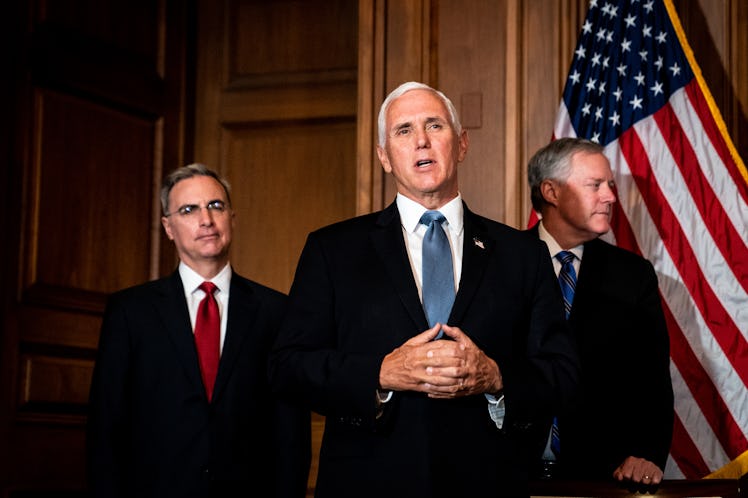
Vice Presidents Do A Lot More Than You Think
Tired of all the national attention pinpointed on President Donald Trump and Democratic presidential candidate former Vice President Joe Biden these days? With the vice presidential debate coming up, it’s finally time to focus on their running mates: current Vice President Mike Pence and Sen. Kamala Harris, respectively. Since vice presidents aren’t usually at the forefront of media attention, many Americans may be unfamiliar with the exact responsibilities that come with the second-highest position in the executive branch — a position that holds much more power than you might think. To make sure you stay informed before the upcoming 2020 election, here’s everything you need to know about what a vice president does, from the official to the unofficial duties.
While it might be easy to think of the veep role as a “backup president,” she or he has a crucial role in running the executive branch. The day to day duties of the position can vary widely, according to the Gerald L. Baliles Professor and Director of Presidential Studies at the University of Virginia’s Miller Center Barbara A. Perry, Ph.D, but they always include serving as a key adviser to and representative of the president, as well as acting as a governing partner.
“[Vice presidents] are really engaged in the administration on a daily basis,” Perry tells Elite Daily. “They’re in their offices, they’re in the meetings, and they’re constantly contributing their ideas, if a president is open to those ideas. So they’re having more impact now, in these more recent years, on shaping policy and in taking control during emergencies.”
Although a vice president operates mainly within the executive branch, they also have duties in the legislative branch. The vice president of the United States also serves as president of the U.S. Senate, and is responsible for presiding over deliberations and allowed to cast tie-breaker votes. During his first year in office, Pence cast a record number of six tie-breaking votes as Senate president, per CNN — more than any other vice president had cast during their inaugural year.
With this kind of legislative pull, a vice president has the power to have the final say on a number of highly divisive issues, such as Pence’s vote to confirm Betsy DeVos as secretary of education, and his vote to allow states to block funding for Planned Parenthood. Pence also cast a tie-breaking vote to move forward and break Senate Democrats’ filibuster on the 2018 nomination of attorney Thomas Farr for a federal judgeship. Progressives regarded Farr as a controversial nominee due to his alleged involvement in efforts to intimidate and suppress Black voters. In a response to a questionnaire from Sen. Dianne Feinstein, Farr stated that he was “not aware” of any voter suppression efforts.
The vice president also plays a significant role in national security matters as a member of the National Security Council. According to an August 2020 report from the nonpartisan think tank the Council on Foreign Relations (CFR), Pence is “the [Trump] administration’s point man in delivering high-profile rebukes of U.S. adversaries,” and is a “highly influential” figure in driving U.S. foreign policy. In a 2019 meeting with ICE Baltimore Field Office leadership, Pence stated that “we have a crisis on our southern border,” referring to the influx of asylum seekers from war-torn countries like Honduras, Guatemala, and El Salvador.
And of course, the vice president is expected to assume office should anything happen to the sitting president. If the president dies, resigns, is incapacitated, or is otherwise removed from office, then the 25th Amendment establishes procedures to ensure a smooth transfer of power. The last time a transfer of power was required was in 2007, when Vice President Dick Cheney briefly acted as commander-in-chief while President George W. Bush was sedated to undergo a medical procedure. (It lasted about two hours and 15 minutes, if you’re wondering.)
That last responsibility is of particular concern following President Trump’s coronavirus diagnosis. On Oct. 1, Trump announced via Twitter that both he and first lady Melania Trump were diagnosed with COVID-19. Although Trump was released from treatment at Walter Reed Hospital to return to the White House on Monday, Oct. 5, there has been plenty of speculation on his ability to carry on with his presidential duties. According to Perry, if the president was too sick to govern, Trump could either sign a letter transferring his powers over to Pence, or — if the president is too incapacitated to sign — “the cabinet and the vice president would have to gather to vote in the majority to invoke the 25th Amendment … and the reins would pass to Pence.”
While the role of vice president was initially something of a presidential backup plan, in modern politics the office has become so prestigious that it’s seen as a path to the presidency itself. To point, Biden served as former President Barack Obama’s vice president for eight years, allowing him to solidify his reputation as a trustworthy Democratic candidate in 2020. Whoever assumes the vice presidency position after the election is decided, one thing is certain: they’ll play an extremely consequential role in shaping the future of America.